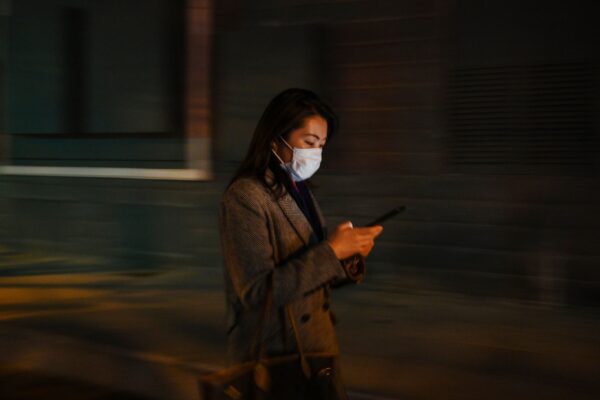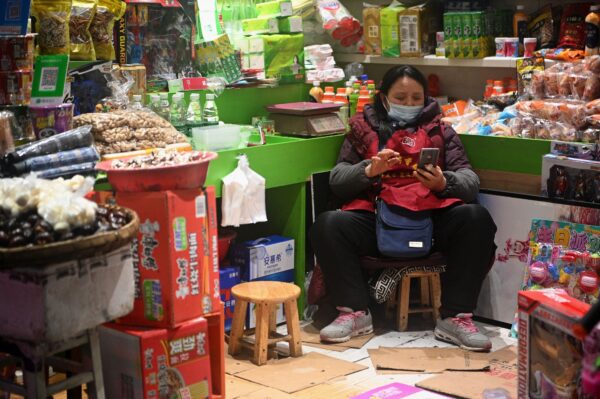Remember, we are dealing with a country with a "social credit" system based on surveillance of the entire country.
21
Million Fewer Cellphone
Users in China May Suggest a
High CCP Virus
Death Toll
22
March, 2020
The
number of Chinese cellphone users dropped by 21 million in the past
three months, Beijing authorities announced on March 19. Deaths due
to the CCP virus may have contributed to the high number of account
closings.
Cellphones
are an indispensable part of life in China.
“The
digitization level is very high in China. People can’t survive
without a cellphone,” Tang Jingyuan, a U.S.-based China affairs
commentator, told The Epoch Times on March 21. “Dealing with the
government for pensions and social security, buying train tickets,
shopping … no matter what people want to do, they are required to
use cellphones.
“The
Chinese regime requires all Chinese to use their cellphones to
generate a health code. Only with a green health code are Chinese
allowed to move in China now. It’s impossible for a person to
cancel his cellphone.”
China
introduced mandatory facial scans on Dec. 1, 2019, to confirm the
identity of the person who registered the phone. As early as Sept. 1,
2010, China required all cellphone users to register phones with
their real identification, by which the state can control people’s
speech via its large-scale monitoring system.
Furthermore,
Chinese people’s bank accounts and social security accounts are
bundled with their cellphone plans; apps on Chinese phones check SIM
cards against the state’s database to make sure the number belongs
to the user.
Beijing
first launched cellphone-based health codes on March 10. All people
in China must install a cellphone app and register their personal
health information. Then the app can generate a QR code, which
appears in three colors, to classify the user’s health level. Red
means the person has an infectious disease, yellow means the person
might have one, and green means the person doesn’t.
Beijing
claimed that the health codes are intended to prevent the spread of
the CCP virus, commonly known as novel coronavirus.

21
Million Cellphone Users
China’s
Ministry of Industry and Information Technology (MIIT) announced on
March 19 the number of phone users in each province in February.
Compared with the previous announcement, which was released on Dec.
18, 2019, for November 2019 data, both cellphone and landline users
dropped dramatically. In the same period the year before, the number
of users increased.
The
number of cellphone users decreased from 1.600957 billion to 1.579927
billion, a drop of 21.03 million. The number of landline users
decreased from 190.83 million to 189.99 million, a drop of 840,000.
In
the previous February, the number increased. According to MIIT, the
number of cellphone users increased in February 2019 from 1.5591
billion to 1.5835 billion, which is 24.37 million more. The number of
landline users increased from 183.477 million to 190.118 million,
which is 6.641 million more.
According
to China’s National Bureau of Statistics, the country’s
population at the end of 2019 was 4.67 million larger than in 2018,
reaching 1.40005 billion.
The
2020 decrease in landline users may be due to the nationwide
quarantine in February, during which small businesses were shut down.
But the decrease in cellphone users can’t be explained in this way.
According
to the operation data of all three Chinese cellphone carriers,
cellphone accounts increased in December 2019 but dropped steeply in
2020.
China
Mobile is the largest carrier, holding about 60 percent of the
Chinese cellphone market. It reported that it gained 3.732 million
more accounts in December 2019, but lost 0.862 million in January
2020 and 7.254 million in February 2020.
China
Mobile’s performance in the same months in 2019 was markedly
different; it gained 2.411 million more accounts in January 2019 and
1.091 million more in February 2019.
China
Telecom is the second-largest carrier, holding about 21 percent of
the market. It gained 1.18 million users in December 2019, but lost
0.43 million users in January 2020 and 5.6 million users in February
2020.
In
2019, it gained 4.26 million in January and 2.96 million in February.
China
Unicom, which hasn’t yet published the data for February, shares
the same experience as the other two telecoms in January 2020 and in
early 2019. The company lost 1.186 million users in January 2020, but
gained 1.962 million users in February 2019 and 2.763 million users
in January 2019.
China
allows each adult to apply for at most five cellphone numbers. Since
Feb. 10, the majority of Chinese students have taken online classes
with a cellphone number due to their schools being ordered to stay
closed. These students’ accounts are under their parents’ names,
which means some parents needed to open a new cellphone account in
February.

Analyzing
the Numbers
The
big question is whether the dramatic drop in cellphone accounts
reflects the account closings of those who have died due to the CCP
virus.
“It’s
possible that some migrant workers had two cellphone numbers before.
One is from their hometown, and the other is from the city they work
in. In February, they might close the number in the city they work in
because they couldn’t go there,” Tang said. Typically, migrant
workers would have gone to their home city for the Chinese New Year
in January, and then travel restrictions would have prevented them
from returning to the city where they held a job.
However,
because there is a basic monthly fee to hold a cellphone account in
China, the majority of migrant workers—the lowest income group—are
likely to only have one cellphone account.
China
had 288.36 million migrant workers as of April 2019, according to the
Chinese National Bureau of Statistics.
On
March 17, Meng Wei, spokesman of China’s National Development and
Reform Commission, said at a monthly press conference in Beijing that
except for Hubei, all provinces reported that more than 90 percent of
their businesses resumed operations. In Zhejiang, Shanghai, Jiangsu,
Shandong, Guangxi, and Chongqing, almost all businesses resumed
production.
If
both the number of migrant workers and the level of employment are
accurate, more than 90 percent of migrant workers have gone back to
work.
The
economic dislocation caused by shutdowns in China may have also led
some people who have an extra cellphone to cancel it. With business
poor or stopped, they may not want to carry the extra expense.
“At
present, we don’t know the details of the data. If only 10 percent
of the cellphone accounts were closed because the users died because
of the CCP virus, the death toll would be 2 million,” Tang said.
The
reported death toll in China doesn’t line up with what can
otherwise be determined about the situation there.
A
comparison with the situation in Italy also suggests the Chinese
death toll is significantly underreported. Italy adopted similar
measures to those used by the Chinese regime. The CCP virus death
toll in Italy of 4,825 translates to a death rate of 9 percent. In
China, where a much larger population was exposed to the virus, the
reported death toll of 3,265 translated to a death rate of only 4
percent, less than half that reported in Italy.
Activities
in the outbreak epicenter of Hubei Province seem to contradict the
reported death toll in China. The seven funeral homes in the city of
Wuhan were reported to be burning bodies 24 hours a day, seven days a
week in late January. Hubei Province has used 40 mobile cremators,
each capable of burning five tons of medical waste and bodies a day,
since Feb. 16.
Lacking
data, the real death toll in China is a mystery. The cancellation of
21 million cellphones provides a data point that suggests the real
number may be far higher than the official number.
The
Epoch Times refers to the novel coronavirus, which causes the disease
COVID-19, as the CCP virus because the Chinese Communist Party’s
coverup and mismanagement allowed the virus to spread throughout
China and create a global pandemic.







No comments:
Post a Comment
Note: only a member of this blog may post a comment.